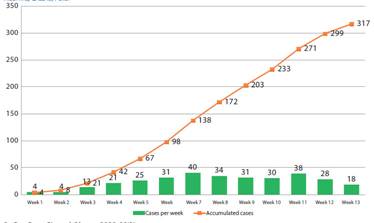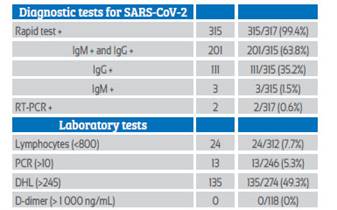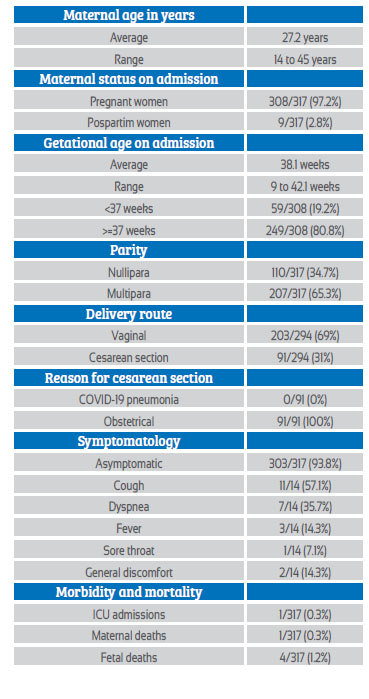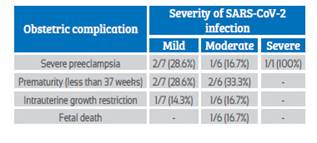Servicios Personalizados
Revista
Articulo
Indicadores
-
 Citado por SciELO
Citado por SciELO
Links relacionados
-
 Similares en
SciELO
Similares en
SciELO
Compartir
Revista Peruana de Ginecología y Obstetricia
versión On-line ISSN 2304-5132
Rev. peru. ginecol. obstet. vol.66 no.3 Lima jul-sep 2020
http://dx.doi.org/10.31403/rpgo.v66i2271
Original Articles
Characteristics of SARS-CoV-2 infection in pregnant and puerperal women at Callao national hospital, Peru
1Hospital Nacional Daniel Alcides Carrión. Callao, Perú
2Clinica Santa Isabel, Lima, Perú
3Centro de Medicina Fetal: CENMEF, Lima, Perú
Introduction: It is known that pregnant women are more susceptible to respiratory infections, but the behavior of the SARS-CoV-2 infection is yet to be known. Objective: To describe the epidemiological characteristics of pregnant and puerperal women infected with SARS-CoV-2 at Hospital Nacional Daniel Alcides Carrión, Callao, Peru. Methods: Descriptive cross-sectional study. All pregnant women hospitalized between May 1 and July 31, 2020 with diagnosis of SARS-CoV-2 infection by either the rapid serological test or the RT-PCR test were selected. Results: During the study period, 671 patients were screened; 308 pregnant women and 9 puerperal women were diagnosed with SARS-CoV-2 infection. The most common symptoms were cough (57%) and dyspnea (35%). 95% were asymptomatic, 2% presented mild disease, 1% moderate, and less than 1% severe disease. Only one maternal death was registered. 69% of deliveries were vaginal and 31% were delivered by cesarean section. Conclusions: The behavior of SARS-CoV-2 infection in the pregnant women studied did not differ from that found in the general population of the same age.
Key words: Coronavirus infections; COVID-19; SARS-CoV-2; Pregnancy; Pregnancy complications; infectious; Pregnancy outcome; Callao; Peru
Introduction
In the presence of cases of pneumonia of undetermined cause at the end of 2019 in Wuhan, a Chinese province of Hubei, the causal agent was identified as SARS-CoV-2, a new virus belonging to the Coronaviridae family. This disease was named Coronavirus Disease 2019 or COVID-19. The infection spread worldwide, being considered a pandemic, with a number of cases that increases to date1,2.
On August 13, 2020, as announced by the Pan American Health Organization (PAHO), there are 10 950 220 cases of infection and 39 229 deaths in the American continent. Peru has an accumulated number of 498 555 infected cases and 21 713 deaths. Callao has documented a total of 1 114 deaths, occupying the second place in deaths in Peru3.
It is known that pregnant women are more susceptible to coronavirus infections as it happened with infections by SARS-CoV-1 (severe acute respiratory syndrome) and MERS-CoV (Middle East respiratory syndrome). Therefore, pregnant women are considered vulnerable population4.
The infection by SARS-CoV-2 is generally transmitted by respiratory droplets (larger than 5 μm) and by direct contact with mucosa, secretions or contaminated material. According to Li5, the period of incubation is 5 to 14 days approximately. The pathophysiology shows a severe and unspecific inflammatory response which produces general symptoms and even alveolar collapse6.
Stumpfe1 observed that most pregnant women are asymptomatic, and the most frequent symptoms, if manifested, are fever, cough, fatigue, dyspnea, sore throat, headache, myalgia and diarrhea.
The main objective of the present study was to describe the epidemiological characteristics in pregnant and puerperal women infected with SARS-CoV-2 at Daniel Alcides Carrion National Hospital, Callao, Peru.
Methods
The present descriptive cross-sectional study reviews the experience in managing pregnant women infected with SARS-CoV-2 at the Gynecology and Obstetrics department of Daniel Alcides Carrion National Hospital, Callao, Peru, between May 1 and July 31 of this year. The data are part of a broader study. All pregnant and puerperal women diagnosed with SARS-CoV-2 during the period reviewed were included. The diagnostic was made using the methodology and criteria approved by the Peruvian Health Ministry (MINSA): rapid serology test or the COVID-19 RT-PCR test.
Universal screening was conducted on all patients hospitalized in our facility. The classification and severity criteria that were taken into account were those proposed by the Peruvian Health Ministry for the SARS-CoV-2 infection7.
Results
671 patients were admitted during the studied period. 317 of them were infected with SARSCoV-2: 97% (308) were pregnant and 2.8%9 postpartum, with a prevalence of 47%. A sustained growth in the number of weekly cases was evidenced (Figure 1) since the first case diagnosed on May 6, reaching its peak on the seventh week ( June). The clinical characteristics of the pregnant women are shown in Table 1. Most pregnant women were asymptomatic (95%), and only one case of severe disease was observed (Figure 2). The main symptoms reported were cough (57%) and dyspnea (35%). The diagnosis for SARS-CoV-2 infection was made almost entirely by rapid serology test (99.4%): 63.8% were positive for IgM + IgG (Table 2). Lymphopenia was found in 7.7% and elevated C-reactive protein in only 5.3% of the studied population.

Figure 1 Weekly and cumulative Frequency oF obstetric cases diagnosed With sars-cov-2 inFection at daniel a. carrión national hospital, callao, peru.

Figure 2 Distribution of the Frequency of the symptoms of obstetric patients diagnosed With sars-cov-2 infection at daniel a. Carrión national hospital.
Table 2 Results of the laboratory tests in obstetric cases diagnosed with sars-cov-2 infection.

RT-PCR=real time polimerase chain reaction; PCR=C-reactive protein; DHL=lactic dehydrogenase.
During the study, 592 deliveries were attended, including vaginal deliveries and cesarean sections. Out of the 294 births in patients with SARS-CoV-2, 69% (203) were by vaginal delivery. All the 91 (31%) cesarean sections performed had obstetric indication. There was only one maternal death by SARS-CoV-2 infection, which was a term pregnant woman who underwent a cesarean section for severe preeclampsia and HELLP syndrome. She was admitted to the ICU postoperatively and progressed torpidly manner, dying 4 days later.
There were four fetal deaths, only one case was in-hospital in a term pregnancy and was attributed to premature placental abruption associated to mild preeclampsia.
The obstetric complications in mild cases were preeclampsia in 28.6%, prematurity in 28.6%, and intrauterine growth restriction (IUGR) in 14.3%. In moderate cases, prematurity was found in 33.3% of cases, preeclampsia in 16.7% and IUGR in 16.7%. Only one case of severe disease was reported associated to preeclampsia and HELLP syndrome. No cases of gestational diabetes or fetal distress were reported in symptomatic patients infected with SARS-CoV-2 (Table 3).
Discussion
The evolution of the pandemic in our hospital is correlated with the increase in cases at the national and local level, reaching a maximum in the month of June (weeks 6 to 9), followed by a new rise caused by the relaxation of the restrictive measures in July (week 11), which is also reflected in national statistics. On August 13, 2020, there were 23 576 confirmed COVID-19 cases in the Callao province, and 230 619 in the metropolitan region of Lima2.
Most of the pregnant women treated for a SARS-CoV-2 infection were asymptomatic, consistent with the publications so far1. This may be explained by adaptative phenomena of pregnancies and the low average age of pregnant women (27 years). In Stumpfe’s1 study, the mean age of symptom onset in the general population was 47 years, and pregnant women are considered part of the asymptomatic population or with mild disease. Only 5% of our expecting mothers was symptomatic and the clinical picture was similar to that found in general series of the pandemic for the population in that age range1,8. Zhang9 enlists fever, cough, dyspnea, myalgia and fatigue as the most frequent symptoms in the general population, which coincides with our findings10. Since ours is a reference hospital, these results cannot be extrapolated to other realities, given that we concentrate pregnant women with complex obstetric pathologies and, as a result of the pandemic, referrals only for the diagnosis of SARSCoV-2 from less complex centers.
The absence of cesarean procedures indicated for SARS-CoV-2 infection coincides with the low percentage of symptomatic cases, as reported by Huerta8 in a smaller number of cases in a hospital in Lima. However, the present study cannot establish if a SARS-CoV-2 infection can intensify other pathologies in pregnant women, such as preeclampsia, growth restriction, chronic hypertension or diabetes11. Elisheva12 maintains that a SARS-CoV-2 infection causes poor vascular perfusion characterized by abnormal placental vessels and intervillous thrombi, that would produce alterations in the oxygenation of the perivillous space; this could be aggravated if a gestational hypertensive disorder is associated.
The present report does not include neonatal data, but no cases of congenital infection related to SARS-CoV-2 were found. This is supported by other international publications.
Given this knowledge, vaginal delivery seems to be a safe to end pregnancy in presence of a SARS-CoV-2 infection10.
The sensibility and specificity rates imparted by the National Health Institute regarding the rapid tests used by the MINSA during this pandemic are 91.8% and 96.4%, respectively7. The laboratory alterations in our cases were similar to those described in the general population; lymphopenia and elevation of C reactive protein were our most frequent findings(1,8). Lactate dehydrogenase and d-dimer values should be assessed in the context of normal values for pregnant women, which have not been established. Thus, we used values for the general population as a reference7,9.
This communication provides the preliminary results of the SARS-CoV-2 pandemic at Daniel Alcides Carrión National Hospital in Callao, Peru. Therefore, its conclusions cannot be final.
We can conclude from our results that the behavior of the SARS-CoV-2 infection in pregnant women did not differ from what was found for the general population of the same age. Vaginal delivery appears to be a safe route to give birth in presence of SARS-CoV-2 infection. The analysis of a larger population is necessary to be able to demonstrate the possible influence of SARSCoV-2 on placental pathology.
REFERENCES
1. Stumpfe FM, Titzmann A, Schneider MO, Stelzl P, Sven K, et al. SARS-CoV-2 Infection in pregnancy a review of the current literature and possible impact on maternal and neonatal outcome. Geburtshilfe Frauenheilkd. 2020;80(4):380-90. doi:10.1055/a-1134-5951 [ Links ]
2. World Health Organization. Coronavirus disease (COVID-19) Situation Report - 162 Data as received by WHO from national authorities by 10:00 CEST, 12 August 2020. https://www.who.int/docs/default-source/coronaviruse/20200630-covid-19-sitrep-162.pdf?sfvrsn=e00a5466_2 [ Links ]
3. Panamerican Health Organization (PAHO) -Countries and territories sorted by cumulative cases. https://paho-co-vid19-response-who.hub.arcgis.com/ [ Links ]
4. Hui DS. Epidemic and emerging coronaviruses (Severe Acute Respiratory Syndrome and Middle East Respiratory Syndrome). Clin Chest Med. 2017;38(1):71-86. doi:10.1016/j.ccm.2016.11.007 [ Links ]
5. Li Q, Guan X, Wu P, Wang X, Zhou L, et al. Early transmission dynamics in Wuhan, China, of novel coronavirus-infected pneumonia. N Engl J Med. 2020;382(13):1199-207. doi:10.1056/NEJMoa2001316 [ Links ]
6. Zhang H, Penninger JM, Li Y, Zhong N, Slutsky AS. Angiotensin-converting enzyme 2 (ACE2) as a SARS-CoV-2 receptor: molecular mechanisms and potential therapeutic target. Intensive Care Med. 2020;46(4):586-90. doi:10.1007/s00134-020-05985-9 [ Links ]
7. Resolución Ministerial Nº 245: Directiva Sanitaria para la prevención y atención de la gestante y el recién nacido con riesgo o infección por COVID -19. MINSA. https://www.gob.pe/institucion/minsa/normas-legales/544144-245-2020-minsa [ Links ]
8. Huerta I, Elías JC, Campos K, Muñoz R, Coronado JC. Características materno perinatales de gestantes COVID-19 en un hospital nacional de Lima, Perú. Rev Peru Ginecol Obstet. 2020;66(2). DOI: https://doi. org/10.31403/rpgo.v66i2245 [ Links ]
9. Zhang XY, Huang HJ, Zhuang DL, Nasser MI, Yang MH, et al. Biological, clinical and epidemiological features of COVID-19, SARS and MERS and AutoDock simulation of ACE2. Infect Dis Poverty. 2020;9(1):99. Published 2020 Jul 20. doi:10.1186/s40249-020-00691-6 [ Links ]
10. Royal College of Obstetricians and Gynaecologists and The Royal College of Midwives Coronavirus (covid-19) infection in pregnancy: information for healthcare professionals. Royal College of Obstetricians and Gynaecologists, 2020 [ Links ]
11. Gidlöf S, Savchenko J, Brune T, Josefsson H. COVID-19 in pregnancy with comorbidities: More liberal testing strategy is needed. Acta Obstet Gynecol Scand. 2020;99(7):948-9. doi:10.1111/aogs.13862 [ Links ]
12. Shanes ED, Mithal LB, Otero S, Azad HA, Miller ES, Goldstein JA. Placental pathology in COVID-19. Am J Clin Pathol. 2020;154(1):23-32. doi:10.1093/ajcp/aqaa08 [ Links ]
7Cite as: Zumalave Grados I, Lacunza Paredes R,BenavidesZavalaG,AliagaYauriM,Paredes Loli L, Sembrera E, Vasquez A, Heredia, Chacaltana J. Characterisrtics of SARS-CoV-2 infection in pregnant and puerperal women at Callao national hospital, Peru. Rev Peru Ginecol Obstet. 2020;66(3). DOI: https://doi.org/10.31403/rpgo.v66i2271
Received: August 18, 2020; Accepted: August 20, 2020











 texto en
texto en 





